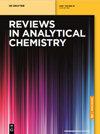TOTAD interface: A review of its application for LVI and LC-GC
IF 3.8
3区 化学
Q2 CHEMISTRY, ANALYTICAL
引用次数: 0
Abstract
Abstract Large volume injection (LVI) in gas chromatography (GC) and online liquid chromatography-gas chromatography (LC-GC) are useful techniques for analyzing the compounds present at very low concentrations in complex samples since they substantially increase the sensitivity of the analysis and simplify sample preparation. LVI avoids the need to concentrate the extract and even the extraction step itself by directly injecting the sample. In online LC-GC, the liquid chromatography (LC) step acts as the sample preparation and/or fractionation step. The main problem in both techniques is the selective elimination of the large volume of solvent without losing the analytes. The TOTAD (through oven transfer adsorption–desorption) interface, based on a widely modified PTV (programmed temperature vaporizer) injector, allows large volumes to be injected into the gas chromatograph using both nonpolar and polar solvents, including water. Consequently, online LC-GC can be carried out whether the LC step is in the normal phase or the reversed phase. Various methods for analyzing trace compounds in food and environmental samples have been developed for LVI and online LC-GC using the TOTAD interface. Such analysis methods require the optimization of several variables common to LVI and online LC-GC and specific variables involved in online LC-GC, which must be optimized by taking into account the nature of the analytes and the characteristics of the sample matrix. This article reviews how each of these variables affects the performance of the analysis.toad接口在LVI和LC-GC中的应用综述
气相色谱(GC)和在线液相色谱-气相色谱(LC-GC)中的大体积进样(LVI)技术是分析复杂样品中极低浓度化合物的有效技术,因为它们大大提高了分析的灵敏度并简化了样品制备。通过直接注射样品,LVI避免了浓缩萃取物甚至萃取步骤本身的需要。在在线LC- gc中,液相色谱(LC)步骤充当样品制备和/或分馏步骤。这两种技术的主要问题是在不损失分析物的情况下选择性地消除大量的溶剂。TOTAD(通过烤箱转移吸附-解吸)界面,基于广泛改进的PTV(程控温度汽化器)进样器,允许使用非极性和极性溶剂(包括水)将大量气体注入气相色谱仪。因此,无论LC步进是正相还是反相,都可以进行在线LC- gc。各种分析食品和环境样品中痕量化合物的方法已经发展为LVI和在线LC-GC使用TOTAD接口。这种分析方法需要对LVI和在线LC-GC共有的几个变量以及在线LC-GC所涉及的特定变量进行优化,这些变量必须结合被分析物的性质和样品矩阵的特点进行优化。本文回顾了这些变量如何影响分析的性能。
本文章由计算机程序翻译,如有差异,请以英文原文为准。
求助全文
约1分钟内获得全文
求助全文
来源期刊

Reviews in Analytical Chemistry
化学-分析化学
CiteScore
7.50
自引率
0.00%
发文量
15
审稿时长
>12 weeks
期刊介绍:
Reviews in Analytical Chemistry publishes authoritative reviews by leading experts in the dynamic field of chemical analysis. The subjects can encompass all branches of modern analytical chemistry such as spectroscopy, chromatography, mass spectrometry, electrochemistry and trace analysis and their applications to areas such as environmental control, pharmaceutical industry, automation and other relevant areas. Review articles bring the expert up to date in a concise manner and provide researchers an overview of new techniques and methods.
 求助内容:
求助内容: 应助结果提醒方式:
应助结果提醒方式:


